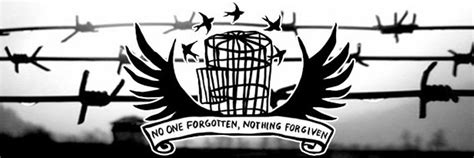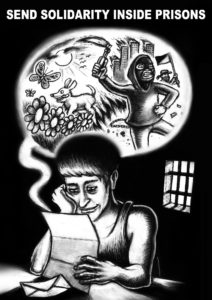What is the Anarchist Black Cross and why does it exist? This text tries to answer the question. The text is from the zine “Starting an Anarchist Black Cross Group: A Guide”.
What is the Anarchist Black Cross?
The Anarchist Black Cross is an international network of anarchist groups and individuals engaged in practical solidarity with prisoners and broader anti-repression struggles.
Prisoner Support
We support revolutionaries, anarchists and others trapped in the prison system. We support and publicise prisoners’ efforts to organise and resist the system from the inside. We try to work through letters, visits, material aid, as well as demonstrations, campaigns and spreading information about prisoners, the reality of prisons and the class system which created them. Fundraising and material support is a key part of our work. Many of us also support prisoners and those affected by repression emotionally, with friendship and solidarity as our weapons. In all of what we do, we try to create links in and out of prisons.
Anti-Repression and Movement Defence Work
The state and those that wish to destroy movements for liberation attack us on many levels. The Anarchist Black Cross network aims to build the infrastructure to be resilient to repression so that we can continue fighting for liberation and support comrades harmed by this state violence. Many groups organise ongoing long-term solidarity campaigns with those affected by various waves of repression across the world. Indeed, many ABC groups start in response to a repressive operation in their region. Movement and community defence can involve many things. The Anarchist Black Cross has been engaged in diverse forms over decades – from legal defence campaigns and committees, to maintaining physical solidarity against the police during factory and school occupations, performing roles of security and physical defence against white supremacist and neo-fascist attacks, as well as engaging in armed defence of social movements. ABC groups also often organise workshops, zines and other material to support people to learn about repression, security culture and solidarity. The Anarchist Black Cross exists to strengthen struggles for freedom and liberation by providing mental, emotional, material, and physical support to individual, groups, communities and movements. Ultimately, we want to help ensure the strength of our movements from the inside out. We want to support struggles to be a threat to state, capitalist, white supremacist, patriarchal power and other forms of domination.
The History of the Anarchist Black Cross
The Anarchist Black Cross Federation in the United States have written an overview of the history of ABC which we have shared below: Since the beginning of the Twentieth Century, the Anarchist Black Cross (ABC), has been on the frontline in supporting those imprisoned for struggling for freedom and liberty. Until recently, the history of the ABC movement has been lost to the pages of time. The present generation of ABC collectives were left rootless with little known information about this organisation. Now, specific questions regarding our origin can now be put to rest. We have now begun to rediscover our roots. The year of origin has been a nagging question regarding the history of the Anarchist Black Cross, also known as the Anarchist Red Cross (ARC). According to Rudolph Rocker, once the treasurer for the Anarchist Red Cross in London, the organisation was founded during the “hectic period between 1900 and 1905.” Despite his involvement in the early stages, we do not feel these dates are very accurate. According to Harry Weinstein, one of the two men who began the organisation, it began after his arrest in July or August of 1906. Once released, Weinstein and others provided clothing to anarchists sentenced to exile in Siberia. This was the early stages of the ARC. He continued his efforts in Russia until his arrival in New York in May of 1907. Once he arrived, he helped to create the New York Anarchist Red Cross. Other accounts place the year origin in 1907. During June and August of 1907, Anarchists and Socialist Revolutionaries gather together in London for two conferences. It is believed that Vera Figner, a Socialist Revolutionary, met with Anarchists to discuss the plight of the political prisoners in Russia. After this meeting, the Anarchist Red Cross organized in London and in New York. In addition to this information, we do know that members of the organisation were on trial in 1906-1907 in Russia. Therefore, We feel the most accurate date of origin for the Anarchist Red Cross would be late 1906- early 1907 for the Russia section; June or August 1907 for the creation of the International section. However, the reason for the creation of the Anarchist Red Cross is not in dispute. It was formed after breaking away from the Political Red Cross (PRC). The PRC was controlled by the Social Democrats and refused to provide support to Anarchist and Social Revolutionary Political Prisoners, despite continued donations from other Anarchists and Social Revolutionaries. As one former Political Prisoner and member of the Anarchist Red Cross stated, “In some prisons there was little distinction made between Anarchists and other Political Prisoners, but in others Anarchists were refused any help.” The newly formed ARC considered these actions criminal and vowed that any prison where Anarchists were in the majority, the ARC would provide support to all Anarchist and Social Revolutionaries Political Prisoners. Because of their support for Political Prisoners, members of the group were arrested, tortured and killed by the Tsarist regime. The organisation was deemed illegal and membership was reason enough for arrest and imprisonment in Artvisky Prison, one of the worst hard labor jails in Siberia. ARC members and prisoners who managed to escape from prison fled from Russia creating chapters in London, New York, Chicago and other cities in Europe and North America. The 1917 Revolution caused a celebration throughout the Socialist, Anarchist, and Communists communities. The ARC liquidated and members began to make plans to return to Russia in hopes of participating in the new society. Sadly, their return was met by Bolsheviks repression, similar to that of the Tsarist era. After a few years of hibernation, the group was forced to resurface to assist the Political Prisoners in the new Bolshevik society. Once again the organisation was made illegal and membership meant imprisonment and/or death. During the Russian Civil War, the ARC’s name changed to the Anarchist Black Cross to avoid confusion with the International Red Cross, also organising relief in the country. It was also during this period that the organisation organized self-defence units against political raids by the Cossack and Red armies. During the next 7 decades the group would continue under various different names but has always considered itself part of the Anarchist Red Cross/Anarchist Black Cross formation. ABC’s support for Political Prisoners spread to the four corners of the globe. What was once a typically Russian-Jewish organisation, now had many faces and ethnicities. During the 1960s, the Anarchist Black Cross was reformed in Britain by Stuart Christie and Albert Meltzer with a focus on providing aid for anarchist prisoners in Francisco Franco’s Spain. The reason for this was Christie’s experience of the Spanish State’s jail and the importance of receiving food parcels. At that time there were no international groups acting for Spanish anarchist and Resistance prisoners. The first action of the re-activated group was to bring Miguel García García, whom Christie met in prison, out of Spain on his release. He went on to act as the group’s International secretary, working for the release of others. In the 80’s, the ABC began to grow and new ABC groups began to emerge in North America. In the United States, the ABC name had been kept alive by a number of completely autonomous groups scattered throughout the country and had grown to support a wide variety of prison issues. The 1990’s and 2000’s brought several ABC formations in North America (ABCC, ABCN, ABCF). The relationship between these formations has always been considered strenuous. The Break the Chains conference in August 2003, along with side bar discussions between collectives, brought about a better working relationship between the ABCF and ABCN formations. (The ABCC was a short lived formations, dying off in the early 1990s.) Various ABC groups have also been existing in Europe in different forms for decades.


